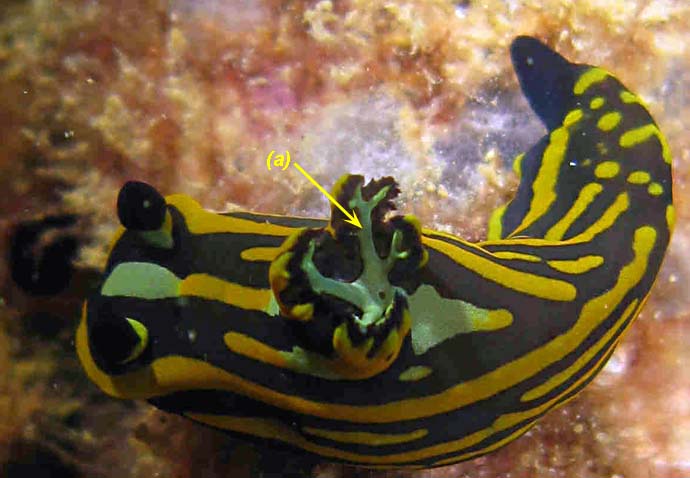This species has been observed on Mauritius, Mayotte and Madagascar Islands
The background color ranges from a translucent indigo blue to a dark bluish black There is a pattern of wide yellow longitudinal bands which in some parts of the pattern change to a milky bluish-green. The rhinophore clubs are dark bluish purple. The whole of the rhinophore sheath, is a milky blue-green. There are three large, somewhat branched, gills. The outside edge is yellow and there is a thin milky blue line up the inner rachis. |
 |
|
| Showing species characteristics... | Photo
Eva Fontaine |
|
Remarks :
Identification confirmed by Nathalie Yonow and Terry Gosliner
Synonymous : (according Yonow, 1990)
- Nembrotha affinis Eliot, 1904: 92, plate 4, figs 3a-d.
- Tambja affinis, Willan & Colemen, 1984: 14, fig 17.
Bibliographic data :
In specimens with a lighter background colour, the yellow bands are seen to have a thin dark blue-black bordering line (which is obscured in those with a dark blue-black background).
Description of the yellow bands pattern :
- There is a broad yellow band around the mantle edge, outlining the anterior end of the body, which runs along each side of the body to just behind the the gills, where the lines on each side solmetimes meet in the dorsal midline and run posteriorly as a single median line for a short distance
- From between the rhinophores a median line runs back to the central gill. The anterior end of that line, between the rhinophores, forms a milky blue-green ovate spot, somewhat wider than the rest of the line.
- On each side of the dorsum, another yellow line runs from about midway between the gills and the rhinophores, back to the outer gill on each side. These two lines, and the median line, have a milky green-blue patch at the anterior base of the gills.
The edge of the foot has a yellow band, and a number of longitudinal yellow lines of similar width run along the sides of the body, sometimes for almost the complete length and sometimes for only a part of the distance.
The rhinophore clubs are dark bluish purple, but in some specimens with a lighter background colour they are translucent yellowish with a deep purplish tip, and basal region. The whole of the rhinophore sheath, not just the edge, is a milky blue-green.
There are three large, somewhat branched, gills. The outside edge is yellow and the pinnae are a dark purplish black. There is a thin milky blue line up the inner rachis.
Below the rhinophore there is a long black ridged structure corresponded to the sensory organ. Usually all we see is a dark line, or groove along the side of the head. But in some photo the sensory organ is 'half open' and in other it is fully everted to show its structure of compound ridges.
This species belong to a group of Tambja with longitudinal yellow lines, but there are some differences between these species.
- In Tambja victoriae the rhinophore sheath are dark blue with yellow border not milky blue-green like in T. affinis. But for many specialists, T. victoriae is only a color variant of T. affinis.
- In Tambja olivaria the background colour is dull olive green, and there is only two yellow longitudinal bands on the dorsum.
- In Tambja gabrielae the rhinophoral clubs are bright yellow with a dark green region on the posterior side of the base.
- In Tambja tentaculata there are four longitudinal yellow lines on the dorsum without the large central milky -blue green patch between rhinophores like in T. affinis.
References :
Bill Rudman Seaslug site : Sea Slug Forum : Tambja affinis
Nudipixel Tambja affinis
Publications :
Eliot, C.N.E. (1904) On some nudibranchs from East Africa and Zanzibar. Part V. Proceedings of the Zoological Society of London, 1904(2): 83-105, Pls. 3-4.
Pola, M., Cervera, J.L. & Gosliner, T. (2005) Four New Species of Tambja Burn, 1962 (Nudibranchia: Polyceridae) from the Indo-Pacific. Journal of Molluscan Studies , 71: 257-267
Yonow, N. (1990) Red Sea Opisthobranchia 3: The orders Sacoglossa, Cephalaspidea, and Nudibranchia: Doridacea (Mollusca, Opisthobranchia). Fauna of Saudi Arabia, 11 : 286-299.
Yonow, N. (1994) Opisthobranchs from the Maldive Islands, including descriptions of seven new species (Mollusca: Gastropoda). Revue fr. Aquariol., 20(4) : 97-130.
Other photos of Tambja affinis :
Eva Fontaine Mayotte, Moinatrindri reef, 5 m, 21 October 2012, size : 30 mm
A second specimen crawling under a large Acrospora table... |
 |
|
|
Fabrice Schubert Mayotte, Boueni, 14 m, 1 November 2010
Below the rhinophore there is a long black ridged structure corresponded to the sensory organ. Usually all we see is a dark line, or groove along the side of the head. But in some photo the sensory organ is 'half open' and in other it is fully everted to show its structure of compound ridges (a). |
Marina Poddubetskaia Mayotte, "Récif de Peïtro", Kongou, 11 m, 15 November 2003, size : 70 mm
This identification was confirmed by Marta Pola who has dissected this specimen. |
 |
 |
Sully Bachel Madagascar, Ile Sainte Marie, 10 m, 17 October 2008,
There are three large, somewhat branched, gills. The outside edge is yellow and the pinnae are a dark purplish black. There is a thin milky blue line (a) up the inner rachis. |
More photos from Indian Ocean
Mauritius, Tambja affinis on a sandy substrate, at Mahebourg, by Yann von Arnim

